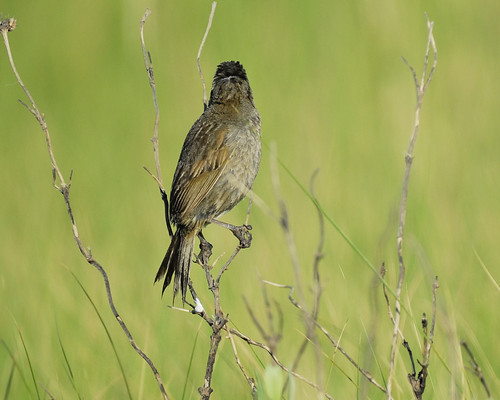tags: Seaside Sparrow, Ammodramus maritimus, birds, mystery bird, bird ID quiz
[Mystery birds] Seaside Sparrow, Ammodramus maritimus, photographed at Anahuac Wildlife Refuge, Texas. [I will identify this bird for you tomorrow]
Image: Joseph Kennedy, 19 May 2009 [larger view].
Nikon D200 ,Kowa 883 telescope with TSN-PZ camera eyepiece 1/750s f/8.0 at 1000.0mm iso400.
Please name at least one field mark that supports your identification.


Let's see, a bird with no eyes and no beak.. You'd think that would make it easy to identify. rb
I'm not sure, but I'm going to guess that this is a dickcissel. The habitat, the bird's general proportions, and the posture feel right for that ID. The hint of streaking on the shoulders, and the bit of olive coloration, pushed me in that direction, too. I flipped through some sparrows, and couldn't find anything that seemed closer to this bird than does the dickcissel. But again, I'm not at all sure, and am interested in finding out the answer.
So you promised yesterday. ;-)
How about Seaside Sparrow of the form _fisheri_? The underparts are fairly dark gray, lacking noticeable yellow on the chest. The back is fairly dark gray too, with some white streaks on brown feathers. The greater coverts are mostly brown, with black tips. The tail has spiky-pointed feathers. Dickcissel ought to show some pale patterning on the back of the head, and some hint of white or yellow on the throat or chest. Their tail feathers shouldn't look spiky.
V.V.nice bird;my best guess is Black-chinned sparrow.
I forgot to mention that the primary projection (beyond the tertials) is very short; Dickcissel has a longer projection.
Ground-petrel, what features of this bird make you think of Black-chinned Sparrow?
I think you're right, Rob, the spiky tail feathers shout Ammodramus, and Seaside is the only one that should be that plain gray underneath, or that nondescript above. The only thing that bothers me is the location and date. Mid-May suggests that the bird should be in fresh plumage, but in fresh plumage, the Gulf Coast Seaside 'should' show distinct black streaks below and stronger contrast above. The atlantic race of Nelson's Sparrow (formerly Nelson's Sharp-tailed Sparrow) can approach this nondescript plumage, at least on the back, but normally winters on the Mid-Atlantic coast, and by mid-May should be starting back north.
Oh, and two more strikes against Dickcissel (interesting idea, actually, I had to check up on that one): 1) the streaking on the back appears to be white on gray, not black on gray. 2) The wing extension (primaries beyond the secondary/tertial/scapulars, depending on the species) is non-existent -- a Dickcissel should show 4 to 5 primary tips on the folded wing, as befits a long-distance migrant.
Similarly, Black-chinned is an interesting idea. The biggest problem is range -- Anahuac is on the upper Texas coast, right next to Louisiana, I believe, and the Black-chinned only makes into west Texas. Beyond that, probably the biggest clue would be the tail feathers. I think the back would probably be a bit brighter with dark streaks, as well. Of course, birds do show up in weird places, so it's worth considering the possibility.
psweet, Seaside Sparrows undergo one molt every year. This complete molt begins in July in Florida and can extend to September (Rising, 2002. Sparrows of the United States and Canada. The Photographic Guide) in that state; I see no reason to think that Texas birds would have a significantly different molt schedule. So, in May, this species can look worn and tattered.
Rob, the belly, wings, and location point to it.
Fair enough, Rob. Thanks for the reference. Actually, my northern location here might be influencing my thoughts here. Mid-May should be the START of the breeding season (I know, not down there) and birds just shouldn't look like that. Ah, well...
Ground-petrel, the location points away from Black-chinned Sparrow; that species would be very unusual in north-eastern coastal Texas. Also, the tail should be longer and the feathers would not have spiky tips. The back and wings should be more distinctly brown with darker streaks, contrasting more with the gray feathers of the neck and the underparts.
Grrlscientist, what is this bird?
:-)